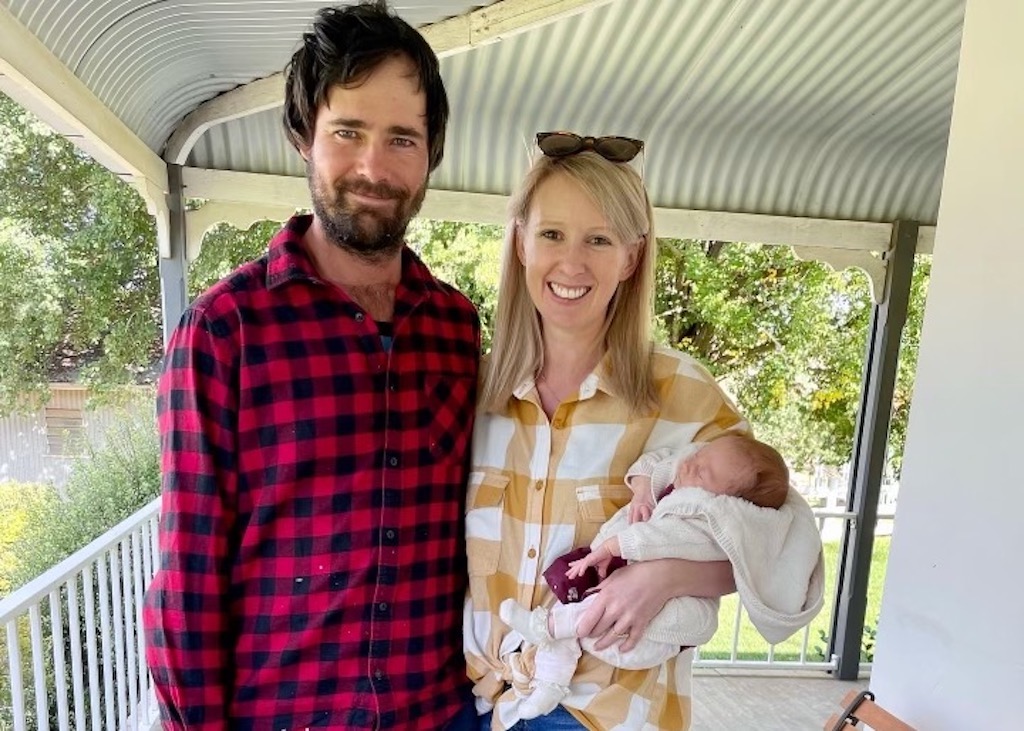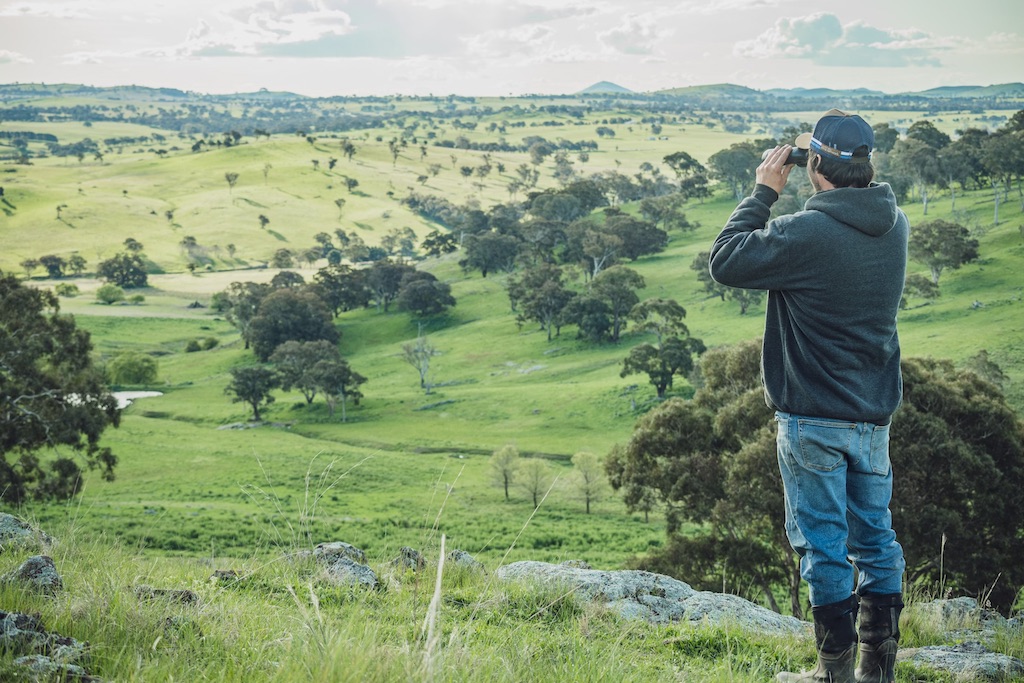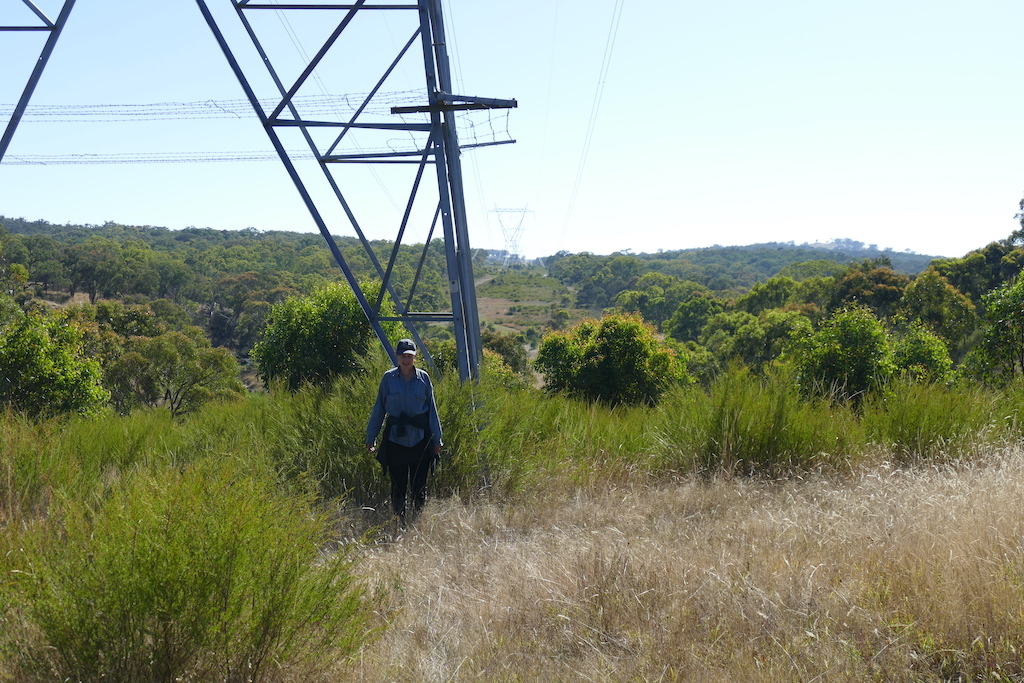
Ashley McGrath and his partner, Amy Wyer, with their four-month-old daughter, Evie. They are losing sleep over the prospect of having their farmland spoiled by Transgrid’s proposed overhead powerlines, which they believe should go underground. Photo: Libby McGrath.
Transgrid’s proposed ”HumeLink’’ transmission will cut through about two kilometres of Ashley McGrath’s farm near Yass. Suspended by six towers, which will be up to 80 metres high, the lines will be 300 m from Ashley and partner Amy Wyer’s house, right outside their kitchen window.
“The lines will cut through well-established hay paddocks, lambing paddocks, tree lines and effectively cut the property in half – straight through the middle,” Ms Wyer said.
The couple has just started a family. Their daughter, Evie, is four months old and Ms Wyer is doing everything she can to ensure the powerlines go underground. She has joined the HumeLink Alliance, which has helped lobby for an inquiry into the feasibility of undergrounding the lines.
“Spending our time talking to Transgrid, solicitors, valuers and trying to ensure landholders stick together isn’t ideal at this time,” Ms Wyer said.
“It’s not ideal for anyone. But having a little one makes you realise how precious your time really is. We won’t get that time back. We won’t be compensated for the sleepless nights worrying about this project or for the moments lost.”
he landholders’ alliance is making a final call for submissions, which close on Friday (14 July), for the NSW Government’s inquiry into the feasibility of undergrounding transmission infrastructure for renewable-energy projects.
The alliance is not against renewable-energy projects. Members say the way to achieving net-zero emissions is to put powerlines underground and protect the environment.
Transgrid’s HumeLink will increase transmission capacity between new-generation sources including the expanded Snowy Hydro and demand centres. The route includes north of Gunning, Crookwell, Taralga and Goulburn en route to Sydney.
Transgrid said putting the 360-kilometre transmission lines underground would push the $3.3 billion cost to $11.5b and force up power prices.
HumeLink Alliance spokeswoman Andrea Strong disputes the figures and said they overlooked the long-term benefits of avoiding overhead powerlines.
“Yes, it will cost more but our argument is when governments overseas factor in environmental and community costs of the overhead lines, underground is the cheapest option,” Ms Strong said.
“Overhead lines start bushfires. On days of extreme fire danger, the risk of bushfires from electrical infrastructure rises dramatically.
“Not only do they start bushfires, they impede your ability to control them. You can’t fight bushfires under powerlines, it is an exclusion zone.”
Given the many billions of dollars worth of losses that major bushfires have caused in Australia, avoiding just one would justify the additional expense of undergrounding powerlines, Ms Strong said.
“The rest of the world is looking on aghast that Australia is building more overhead transmission lines,” she said.

Ashley McGrath taking in the surrounding countryside that would be devastated by the outbreak of a major bushfire. Photo: Amy Wyer.
She said moving to net-zero emissions overseas, nations were putting transmission underground. She cited Germany’s 700 km underground SuedLink transmission line and Canada-New York’s 550 km submarine and underground Champlain Hudson Power Express.
Ms Strong said Tasmania and Victoria’s Marinus Link’s submarine and underground line included 90 km of undergrounding, about a quarter of the distance of the HumeLink’s 360 km line.
Ms Strong said when people pictured overhead powerlines, they thought of the existing infrastructure, which included towers about 35 m high. But the proposed HumeLink towers rise to 80 m.
“There is incredible industrialisation of the landscape of great natural beauty,” she said. “The construction is one-off, but the impact on the environment is for the next 80 to 100 years.”
The Legislative Council Standing Committee on State Development’s inquiry into and report on the feasibility of undergrounding the transmission infrastructure for renewable-energy projects will have particular reference to:
- The costs and benefits of undergrounding
- Existing case studies and current projects regarding similar undergrounding of transmission lines in domestic and international contexts
- Any impact on delivery timeframes of undergrounding
- Any environmental impacts of undergrounding.

Andrea Strong says people can expect towers almost four times higher than the existing transmission structures across the Goulburn region. Photo: Supplied.
Ms Wyer said if people believed undergrounding would lessen the impact of transmission lines on their community, they should make a submission.
“Your submission does not have to be a complicated document,” she said.
”It can be short and to the point. Submissions will close on Friday, 14 July. Now is the time to voice your concerns.”
To lodge a submission, click here. The committee is due to report its findings by 31 August, 2023.







